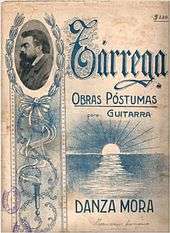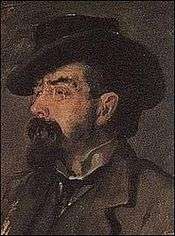Francisco Tárrega

Francisco de Asís Tárrega y Eixea (21 November 1852 – 15 December 1909) was a Spanish composer and classical guitarist of the Romantic period.
Biography
 |
"Recuerdos de la Alhambra"
Performed by Carlo Alberto Boni |
| Problems playing this file? See media help. | |
Tárrega was born on 21 November 1852, in Villarreal, Province of Castellón, Spain. It is said that Francisco's father played flamenco and several other music styles on his guitar; when his father was away working as a watchman at the Convent of San Pascual, Francisco would take his father's guitar and attempt to make the beautiful sounds he had heard. Francisco's nickname as a child was "Quiquet".
As a child, he ran away from his nanny and fell into an irrigation channel and injured his eyes. Fearing that his son might lose his sight completely, his father moved the family to Castellón de la Plana to attend music classes because as a musician he would be able to earn a living, even if blind. Both his first music teachers, Eugeni Ruiz and Manuel González, were blind.
In 1862, concert guitarist Julián Arcas, on tour in Castellón, heard the young Tárrega play and advised Tárrega's father to allow Francisco to come to Barcelona to study with him. Tárrega's father agreed, but insisted that his son take piano lessons as well. The guitar was viewed as an instrument to accompany singers, while the piano was quite popular throughout Europe. However, Tárrega had to stop his lessons shortly after, when Arcas left for a concert tour abroad. Although Tárrega was only ten years old, he ran away and tried to start a musical career on his own by playing in coffee houses and restaurants in Barcelona. He was soon found and brought back to his father, who had to make great sacrifices to advance his son's musical education.
Three years later, in 1865, he ran away again, this time to Valencia where he joined a gang of gypsies. His father looked for him and brought him back home once more, but he ran away a third time, again to Valencia. By his early teens, Tárrega was proficient on both the piano and the guitar. For a time, he played with other musicians at local engagements to earn money, but eventually he returned home to help his family.
Tárrega entered the Madrid conservatory in 1874, under the sponsorship of a wealthy merchant named Antonio Canesa. He had brought along with him a recently purchased guitar, made in Seville by Antonio de Torres. Its superior sonic qualities inspired him both in his playing and in his view of the instrument's compositional potential. At the conservatory, Tárrega studied composition under Emilio Arrieta who convinced him to focus on guitar and abandon the idea of a career with the piano.
By the end of the 1870s, Tárrega was teaching the guitar (Emilio Pujol, Miguel Llobet, and Daniel Fortea were pupils of his) and giving regular concerts. Tárrega received much acclaim for his playing and began traveling to other areas of Spain to perform. By this time he was composing his first works for guitar, which he played in addition to works of other composers.
During the winter of 1880, Tárrega replaced his friend Luis de Soria, in a concert in Novelda, Alicante, where, after the concert, an important man in town asked the artist to listen to his daughter, María José Rizo, who was learning to play guitar. Soon they were engaged.

In 1881, Tárrega played in the Opera Theatre in Lyon and then the Paris Odeon, in the bicentenary of the death of Pedro Calderón de la Barca. He also played in London, but he liked neither the language nor the weather. There is a story about his visit to England. After a concert, some people saw that the musician was in low spirits. "What is the matter, maestro?" they asked him. "Do you miss home? Your family, perhaps?" They advised him to capture that moment of sadness in his music. Thus he conceived the theme of one of his most memorable works, Lágrima (literally meaning teardrop). After playing in London he came back to Novelda for his wedding. At Christmas 1882, Tárrega married María José Rizo.
To enlarge his guitar repertory and, no doubt, to make use of his considerable knowledge of keyboard music, he soon began transcribing piano works of Beethoven, Chopin, Mendelssohn and others. Tárrega and his wife moved to Madrid, gaining their living by teaching privately and playing concerts, but after the death of an infant daughter during the winter, Maria Josefa de los Angeles Tárrega Rizo, they settled permanently in Barcelona in 1885. Among his friends in Barcelona were Isaac Albéniz, Enrique Granados, Joaquín Turina and Pablo Casals.

Francisco Tárrega and María José (María Josefa) Rizo had three more children: Paquito (Francisco), Maria Rosatia (María Rosalia) (best known as Marieta) and Concepción. On a concert tour in Valencia shortly afterward, Tárrega met a wealthy widow, Conxa Martinez, who became a valuable patron to him. She allowed him and his family use of a house in Barcelona, where he would write the bulk of his most popular works. Later she took him to Granada, where the guitarist conceived the theme for "Recuerdos de la Alhambra", which he composed on his return and dedicated to his friend Alfred Cottin, a Frenchman who had arranged his Paris concerts.
From the later 1880s up to 1903, Tárrega continued composing, but limited his concerts to Spain. In 1900, Tárrega visited Algiers, where he heard a repetitive rhythm played on an Arabian drum. The following morning he composed "Danza Mora" based on that rhythm. In about 1902, he cut his fingernails and created a sound that would become typical of those guitarists associated with his school. The following year he went on tour to Italy, giving highly successful concerts in Rome, Naples, and Milan.
In January 1906, he was afflicted with paralysis on his right side, and though he would eventually return to the concert stage, he never completely recovered. He finished his last work, "Oremus", on 2 December 1909. He died in Barcelona thirteen days later, on 15 December, at the age of 57.
Musical style
As a composer Tárrega was conservative, his style was similar to the general trends in the second half of the 19th century. A virtuoso on his instrument, he was known as the "Sarasate of the guitar".
Tárrega is considered to have laid the foundations for 20th century classical guitar and for increasing interest in the guitar as a recital instrument. Tárrega preferred small intimate performances over the concert stage.
Compositions

Francisco Tárrega composed 78 original scores and 120 transcriptions – mostly for his own use.
As with several of his Spanish contemporaries, such as his friend Isaac Albéniz, he had an interest in combining the prevailing Romantic trend in classical music with Spanish folk elements, and transcribed several of Albéniz's piano pieces. The contemporary guitarist and composer Angelo Gilardino has written that Tárrega's 9 Preludios are "... the deepest musical thought of Tárrega in the most concentrated form."
He is also the composer of Gran Vals, an excerpt of which was used in the iconic Nokia ringtone.
Guitars
The guitars used by Tárrega include:
- Torres, FE 17 (1864) – This is the guitar that was given to Tárrega by Torres personally after hearing him play.
- Torres, SE 49 (1883)
- Torres, SE 114 (1888); in the collection of Sheldon Urlik[1][2]
Notes
- ↑ Photo of a Torres guitar used by Tárrega
- ↑ Photo: "Jeff Elliott (left) restored these important guitars by Gonzalez and Torres. They are owned by Shel Urlik (center) and were played by Kenton Youngstrom (right.)" (source)
References
- Francisco Tárrega Biografía Oficial by Adrián Rius Espinós, published by Ayuntamiento de Vila-Real, ISBN 84-88331-82-7
- Francisco Tárrega – Selección de Obras by Adrián Rius Espinós (includes CD with historical recordings by Josefina Robledo; example: "Capricho árabe", published by Excmo. Ayuntamiento de Vila-Real and Instituto Valenciano de la Música
- Francisco Tárrega, Werden und Wirkung by Wolf Moser, published by Edition Saint-Georges. ISBN 3-00-012750-X.
- Francisco Tárrega, Complete Guitar Works by Michel Beauchamp, edited by Productions d'Oz. ISBN 978-2-89655-079-1
- Francisco Tárrega y la guitarra en Espana entre 1830 y 1960 by Wolf Moser, published by Piles Editorial de Música S.A. ISBN 978-84-96814-34-9
- Francisco Tárrega, Collected Guitar Works, reprints of early editions, by Rafael Andia, Chanterelle 1001 and 1002. ISBN 3-89044-125-4
External links
| Wikimedia Commons has media related to Francisco Tárrega. |
- Free scores by Francisco Tárrega at the International Music Score Library Project
- The Mutopia Project has compositions by Francisco Tárrega
- Francisco Tárrega at the Internet Movie Database
- Free Scores and biography
- Complete work and biography (with MIDI music files, that are not at all reflective of Tárrega's performance style, but instead of sheetmusic)
- Tárrega / Walter Leckie Manuscripts, www.theguitarmuseum.com
- Francisco Tárrega and Música by Carmen Copovi Llop (Spanish)
- Photos from Francisco Tárrega's room in the Vila-real City Museum
- Monument in Vila-Real
- Estudio Temático Filatélico sobre Francisco Tárrega at the Wayback Machine (archived October 27, 2009) by Salvador Carracedo Benet (Spanish)